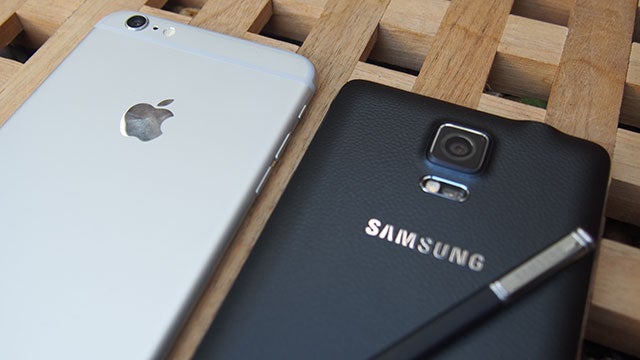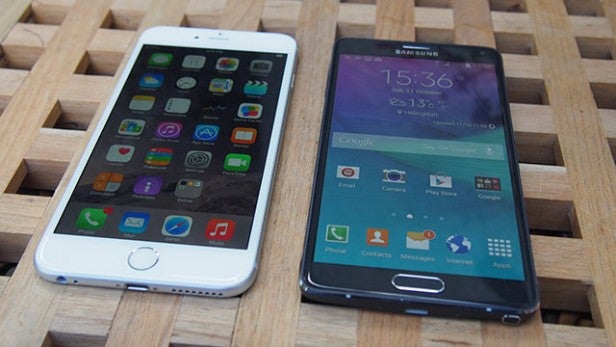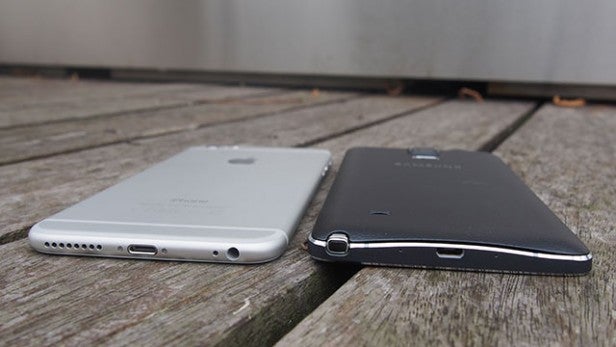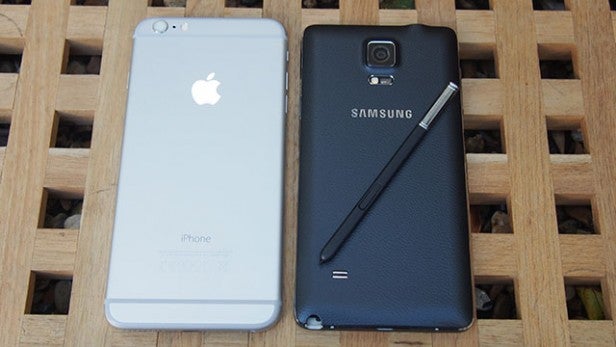iPhone 6 Plus vs Galaxy Note 4: Which big smartphone should you buy?

Note 4 or iPhone 6 Plus? We compare the two phablets to give you our verdict on whether you should go for Apple or Samsung’s big smartphone
The iPhone 6 Plus is the biggest phone Apple has ever made. Moving to a 5.5-inch screen meant it was finally joining the phablet party with the likes of HTC, Samsung, Sony and LG. Judging by the figures in its last earnings report, it has been well received. But it’s not quite as big as the Samsung Galaxy Note 4, the latest S Pen-packing handset that’s arguably one of the standout phones of 2014 and has been succeeded by the Note 5.
We’ve been living with both handsets taking up a little more space than usual in our jeans pockets to help you decide whether the iPhone 6 Plus or the Note 4 should be the phablet to own right now.
Watch the iPhone 6 Plus vs Note 4 video
Related: iPhone 6S Plus
iPhone 6 Plus vs Samsung Galaxy Note 4: Design
iPhone 6 Plus: Curved aluminium, dark/light grey or gold, 7.1mm
Galaxy Note 4: Metal edge, plastic back, gold/blue/black/white, 8.5mm
Samsung gets a lot of stick for its phone designs, but like the Galaxy Alpha, the Note 4 embraces metal for the first time and it really pays off. Replacing the naff plastic trim with a cool anodized aluminium gives the phone a much sleeker profile.
Samsung has also ditched the cheap-looking fake stitching we saw in the Note 3 and despite packing a bigger screen, it’s still one of the most manageable big phones to use in one hand. For a purer, more aesthetically pleasing design, it doesn’t quite match the new iPhone 6 Plus’s much sleeker, slimmer design.
The curved aluminium body of the new iPhone is simply nicer to hold. It’s a little taller than the Note 4 but it’s also significantly thinner than the Samsung phablet. It’s 7.1mm thick, against the Note 4’s 8.5mm, and it shows. As for the bendgate issues, well, we can safely say we didn’t have any problems with the iPhone 6 Plus going wonky.
One big advantage the Note 4 has over the 6 Plus is the ability to access to the battery via the removable back. That’s going to make it a little easier to service than the fully enclosed 6 Plus. Lurking behind that plastic cover is a microSD card support slot to expand storage, something you’ll never find on any Apple phone.
The Note 4 has an important feature the iPhone 6 Plus lacks too – the S Pen. This is a digitiser stylus that offers pressure sensitivity and a frankly excellent writing/note taking experience. It’s pretty great, and is the most convincing reason to buy a Note 4 over the iPhone 6 Plus. Or any other large-screen phone.

Related: Samsung Galaxy S6 vs iPhone 6
iPhone 6 Plus vs Samsung Galaxy Note 4: Screen
iPhone 6 Plus: 5.5-inch 1,920 x 1080 LCD, scratch resistant glass
Samsung Galaxy Note 4: 5.7-inch 2,560 x 1,440 Super AMOLED, scratch resistant glass
Apple has offered great quality displays on its smaller iPhones but now it’s playing with the big boys and Samsung has things well covered here.
With the iPhone 6 Plus you get a 5.5-inch 1080p IPS LCD, while the Galaxy Note 4 offers a slightly larger 5.7-inch QHD screen with a much higher 2,560 x 1,440 pixel resolution. On the numbers alone there’s only one winner – Samsung.
We don’t think this is a war about resolutions, and what really matters are the qualities of the differing screen technologies these two use. The iPhone 6 Plus has an IPS LCD screen, the Note 4 a Super AMOLED one.
Super AMOLEDs trounce all LCDs for black level and contrast, meaning the Note 4 will look a good deal better in a darkened room. Colours are punchy and vibrant as well making it a great for gaming and watching video. Out of the box you’ll want to tinker with the display settings to get the best viewing experience, though.
Apple’s LCD panel might not be able to match the Samsung’s AMOLED display for super-sharp resolution but it’s still excellent in many ways. It’s bright, offers good outdoor visibility and both contrast and black levels impress.
It’s difficult to separate the two but we’d say Samsung just edges it.
iPhone 6 Plus vs Samsung Galaxy Note 4: Connectivity
iPhone 6 Plus: Bluetooth 4.0, 4G/LTE, Wi-Fi 802.11ac, NFC (Apple Pay only), Lightning connector USB 2.0, Airdrop, Continuity, Car Play
Samsung Galaxy Note 4: Bluetooth 4.0, 4G/LTE, Wi-Fi 802.11ac, NFC, Infrared, USB on the go, USB host, Mirror Link
Like the iPhone 6, the 6 Plus is Apple’s most connected smartphone yet, though it still only works best other Apple devices.
Both have Bluetooth 4.0 support to wirelessly connect to headphones, speakers and wearables like an Android Wear smartwatch. NFC has been around on Samsung phones for some time and unlike its introduction to the iPhone 6 Plus, it’s not just restricted to making mobile payments.
Both phones offer 4G support although the 6 Plus offers a more comprehensive list of 4G/LTE networks. iOS 8 also adds some great connectivity features – as long as you’ve bought into the Apple ecosystem that is.
Continuity is a big play for Apple bringing iOS and Mac devices closer together so you can take calls on your MacBook for example. Samsung doesn’t have the same level of integration, but Google is working on similar functionality with Chromebooks where you’ll be able to receive the same phone notifications on the Chrome OS-running laptops.
Related: Note 4 vs Note 3

iPhone 6 Plus vs Samsung Galaxy Note 4: Performance
iPhone 6 Plus: 64-bit Apple A8 dual-core 1.4GHz, GPU PowerVR GX6450, 1GB RAM, M8 co-processor
Samsung Galaxy Note 4: 32-bit 2.7 GHZ Quad-core Snapdragon 805 processor, Adreno 420 GPU, 3GB RAM
On paper the Note 4 has the most brute force. It runs on the latest Snapdragon processor, has more RAM and the latest Adreno GPU to handle the most demanding mobile gaming.
The iPhone 6 Plus is no slouch, though. It runs on the new A8 processor and with the quad-core PowerVR GPU can cope with high intensity 3D gaming as well.
The story the benchmarks tell is that the Note 4 is way ahead of the 6 Plus. In Geekbench 3 tests, the Samsung phone scores an impressive 3,162 multi-core score compared to the 2,871 the 6 Plus manages. It’s a little more even for single core scores though.
To live with on a day-to-day basis both phones are well equipped to handle everyday tasks and more intensive elements like streaming, gaming and music playback. The Note 4’s power is more suited to multitasking, one of its most impressive features, while the 6 Plus wins when it comes to games.
IPhone 6 Plus vs Samsung Galaxy Note 4: Speaker quality
iPhone 6 Plus: Single speaker on bottom edge
Samsung Galaxy Note 4: Single rear-mounted speaker
For sound, both phones are evenly matched and when we say that we mean they are not very good. Samsung has repositioned its sole speaker to the back of the phone while Apple has stuck with keeping its speaker on the bottom edge of the phone.
If you are hoping for the kind of full-bodied, warm audio you can find with HTC’s BoomSound speakers, then prepare to be disappointed.
Both speakers are better suited for loudspeaker conversations and while the iPhone might offer a little more depth, these are no match for the speakers on the One M8. Stick the headphones in and things are much better.
Related: iPhone 6 Plus vs Note 4

iPhone 6 Plus vs Samsung Galaxy Note 4: Software
iPhone 6 Plus: iOS 8.4
Samsung Galaxy Note 4: Android 5.0.1 with TouchWiz UI
If you have to pick an operating system that’s the easiest to use for smartphone newbies, the iPhone 6 Plus still comfortably wins this battle. While you don’t have the same level of customization as Android, the learning curve is much shorter with iOS and in the latest version Apple adds features that Android users have enjoyed for some time to help level the playing field.
The Note 4, though, sees Samsung take an approach to its operating system where it has begun to strip away some of the bloatware and the more gimmicky settings that are largely left untouched by most users. The iPhone 6 Plus in comparison doesn’t pack the OS with additional apps and the core ones it does include provide a solid overall experience.
If you are after more quirky software additions, then the Note 4 is the one to go for. Features like Multi-Window, where you can run multiple apps on the same screen, makes good use of the large display while apps like S Health take advantage of the new heart and UV sensors to monitor health and fitness. Samsung has now updated the Note 4 to run Android 5.0 Lollipop, but there’s still no sign of Android 5.1, which makes a series of fixes while adding features like HD voice calling and improved device protection.
When it comes to app stores, both are evenly matched but you are likely to find more quality in Apple’s storefront than the Google Play rapidly improving outlet. There’s some upscaling issues with the iPhone 6 Plus to be wary of, though. Samsung’s own Galaxy App store offers some nice exclusive offers for Samsung users but you are best sticking to the Google Play Store.
If we had to choose, we’d still opt for Apple’s more user-friendly software approach.
iPhone 6 Plus vs Samsung Galaxy Note 4: Camera
iPhone 6 Plus: 8-megapixel camera sensor, optical image stabilization, TrueTone flash, phase detection, 1.2-megapixel front-facing camera, 1080p HD video recording
Samsung Galaxy Note 4: 16-megapixel sensor, optical image stabilization, 3.7-megapixel front-facing camera, 4K video recording
Having spent a decent amount of time with both cameras, it’s fair to say that they are both fully capable of taking great photos. You don’t need to read a great deal into the megapixel count, the Note 4 and the Plus both shoot detailed images up close or from afar.
The big change here is the addition of optical image stabilization. This is the first iPhone to include it and likewise, if you discount the Samsung Galaxy Zoom range, this is the first big Samsung phone to pack it as well. The chief benefits here are to shoot better quality photos in low-lit conditions. While you won’t get dedicated camera quality, it’s a big improvement especially for the Note 4.
Related: Samsung Galaxy S6 vs S5

iPhone 6 Plus close-up photo sample

Samsung Galaxy Note 4 close-up photo sample

iPhone 6 Plus landscape photo sample

Samsung Galaxy Note 4 landscape photo sample
HDR is fast becoming an integral part of sprucing up photos on your phone and both handsets include it. We’d be inclined to say that it is slightly more impressive on the Samsung phone but the iPhone still has the capability of brightening up shadowy elements in a really rewarding way.
The iPhone 6 camera app shades it for simplicity and ease of use, but we’d say these cameras are evenly matched overall.
iPhone 6 Plus vs Samsung Galaxy Note 4: Battery Life
iPhone 6 Plus: 2915mAh
Samsung Galaxy Note 4: 3220mAh battery
When you compare battery sizes, the Samsung phablet has the bigger one but that’s no surprise when you consider it has a slightly larger high resolution 5.7-inch display.
Despite that, the Samsung phone still manages to go for two days without tapping into the handy ultra-power saving power mode. The 6 Plus boasts impressive battery life, but in our more intensive testing the Note 4 manages an extra hour more than the Apple smartphone.
Both are quick chargers and thanks to the Note 4’s Snapdragon 805 processor, the Samsung phablet now supports Quick Charge technology. This means the Samsung phone can get up to 40% of charge in thirty minutes. It’s very impressive.
iPhone 6 Plus vs Samsung Galaxy Note 4: Price
The Note 4 is only available in a 32GB model and at £599 SIM-free, it doesn’t come cheap. The iPhone 6 Plus in comparison starts from £619 for the 16GB model moving to £699 for the 64GB model and a whopping £789 for the 128GB 6 Plus.
That’s a whole lot of money to own an iPhone 6 Plus, even at the entry-level price. If you wanted to match the Apple’s top-end storage capacity an additional 128GB microSD card is going to cost you around £60 pushing the Note 4 up around the £660 mark, which is still cheaper than the 64GB iPhone 6 Plus.
If it’s value for money you are after here, the Note 4 definitely comes out on top.
The Verdict
It doesn’t take very long living with the Note 4 and the iPhone 6 Plus to see that these are two great big phones and arguably the best options available at the moment.
Which is the best? If you are basing your purchase on design and ease of use, it’s the iPhone 6 Plus. For innovation, the Note 4 is the one to go for. Samsung’s phablet also promises the better battery life despite having a bigger, more demanding display. The stylus is a bonus as well if want to mix things up.
These are two phones that really grow on you the more time you spend with them and discover their strengths and weaknesses. Apple’s first stab at a phablet is a good one, while Samsung’s Note series just keeps on getting better.
Still have some questions about the Note 4 or the iPhone 6 Plus? Let us know in the comments section below


